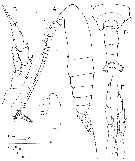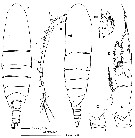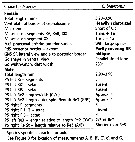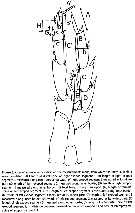|
|
 |
Fiche d'espèce de Copépode |
|
|
Calanoida ( Ordre ) |
|
|
|
Calanoidea ( Superfamille ) |
|
|
|
Calanidae ( Famille ) |
|
|
|
Calanoides ( Genre ) |
|
|
| |
Calanoides brevicornis (Lubbock, 1856) (F,M) | |
| | | | | | | Syn.: |
Calanus brevicornis Lubbock, 1856; Seguin & al., 1993 (p.23, Table 2: abundance, %);
Calanus macrocarinatus Brodsky, 1967 b (p.224, 225, nomen nudum ); 1972 (1975) (p.9, 71, 120, 122, figs.F); Vyshkvartzeva, 1976 (p.14); 1977 (p.97, figs.);
Calanoides macrocarinatus : Carter, 1977 (1978) (p.35); De Decker, 1984 (p.325, 330: chart); Bradford-Grieve, 1994 (p.29, fig.9); Bradford-Grieve & al., 1999 (p.877, 907, figs.F,M); Razouls & al., 2000 (p.343, tab. 3, Appendix); Sabatini & al., 2007 (p.356, figs.13, 14).
Non Calanoides brevicornis : Dakin & Colefax, 1940. After Bradford-Grieve & al. (2017, p.831) the species from off Sydney (western Tasman Sea), figure of the male P5 shows that it differs from any other described species. | | | | Ref.: | | | Bradford-Grieve & al., 2017 (p.816, table 1, 5, figs. 2, 12, phylogeny) |  issued from : J.M. Bradford-Grieve in The Marine Fauna of New Zealand: Pelagic Calanoid Copepoda. National Institute of Water and Atmospheric Research (NIWA). New Zealand Oceanographic Institute Memoir, 102, 1994. [p.30, Fig.9]. As Calanoides macrocarinatus. Female: A, habitus (left lateral side); B, P5. Male (from Bradford, 1970 as Calanoides carinatus): C, anterior body (left lateral side); D, posterior body (dorsal); E, P5.
|
 issued from : M. E. Sabatini, F. C. Ramirez & J. Bradford-Grieve in Invert. Syst., 2007, 21. [p.357, Fig.13]. Female (from 42°24.5'S, 174°01.8'E): A, habitus (dorsal); B, same (lateral; arrowhead indicates heavily sclerotised ventrolateralborder of cephalosome); C-D, genital double-somite, with spermatheca; E, P1 (anterior view); F, P1 left exopod segment 1 (lateral); Re1 = exopod segment 1, Ri1 = endopod segment 1.
|
 issued from : M. E. Sabatini, F. C. Ramirez & J. Bradford-Grieve in Invert. Syst., 2007, 21. [p.358, Fig.14]. Male (same locality): A, habitus (lateral; note A1 longer than usual because segments are expanded apart); B, P1 (anterior; endopod is not figured); C, endopod of P1 (anterior); D, P5 (anterior; L = left, R = right); E, P5, distal end of left exopod (anterior; note surface spinules on posterior surface); F, P5, distal border of right basis (anterior; arrowed indicates smooth border).
|
 issued from : M. E. Sabatini, F. C. Ramirez & J. Bradford-Grieve in Invert. Syst., 2007, 21. [p.361, Table 4]. Comparison characters to distinguish Females as C. macrocarinatus and C. carinatus .
|
 issued from : M. E. Sabatini, F. C. Ramirez & J. Bradford-Grieve in Invert. Syst., 2007, 21. [p.361, Table 4]. Comparison characters to distinguish Males as C. macrocarinatus and C. carinatus.
|
 Issued from : J.M. Bradford-Grieve, E.L. Markhaseva, C.E.F. Rocha & B. Aniahy inSouth Atlantic Ziooplankton, 2. Edit. D. Boltovskoy, 1999. [p.979, Fig. 7. 11]. As Calanoides macrocarinatus. With doubt. Female & Male: Ce = cephalosome; Ur = urosome; Gns = genital double-somite.
|
 Issued from : J.M. Bradford-Grieve, L. Blanco-Bercial & I. Prusova in J. Nat. Hist., 2017, 51 (13-14) [p.828, Table 5]. Character states distinguished known of Calanoides. A1 = antennule, a = aesthetasc; approx. = approximately; CR = caudal rami; Gns = genital double-somite; Go = genital operculum; ms = modified seta; Pd5 = pedigerous somite 5; P5 = fifth leg; Re = exopod; Ri = endopod; SR = seminal receptacle; St = terminal spine.
|
 Issued from : J.M. Bradford-Grieve, L. Blanco-Bercial & I. Prusova in J. Nat. Hist., 2017, 51 (13-14) [p.812, Fig. 3]. Calanoides male P5 indicating the measurements made, from which the ratios in Table 5 were calculated.
|
 Issued from : J.M. Bradford-Grieve, L. Blanco-Bercial & I. Prusova in J. Nat. Hist., 2017, 51 (13-14) [p.827, Fig. 12]. Charactristic to discriminate between females of C. natalis, C. carinatus and C. brevicornis.
| | | | | Ref. compl.: | | | ? [Fleminger, 1985 (p.275, 285, Table 1, 4, Rem.: A1); Bradford, 1988 (p.77); Bradford & al., 1988 (p.301, figs. N, juv.); Bucklin & al., 2003 (p.335, tab.2, Biomol.); Chaouadi & Hafferssas, 2018 (p.913, Table II: occurrence). | | | | NZ: | 2 + 1 douteuse | | |
|
Carte de distribution de Calanoides brevicornis par zones géographiques
|
| | | | | | | Loc: | | | off SW coast of South Africa; W Medit. (Habibas Is., Alboran Sea), SW Pacific. (42.40° S, 174.03*-178.47° E)
Type locality: 35.17° S, 18.07° E | | | | N: | 10 | | | | Lg.: | | | (196) F: 3,7-3,2; M: 3,9-3,3; (313) F: 3-4; M: 3,3-3,6; (323) F: 3,8-3,55; {F : 3,2-4; M: 3,3-3,9} | | | | Rem.: | épi-bathypélagique.
Sampling depth (sub-Antarct.): 0-500 m.
Nota: Farran (1929) found that Atlantic specimens were smaller than 3 mm. Brodsky (1967) found two size ranges (2.4-2.6 mm and 3.7-3.8 mm) and considered that the larger specimens were morphomogically distinct. These he called C. macrocarinatus without formal description, but this distinction is not recognised by Bradford (1970 a, p.352)
Calanoides macrocarinatus is a junior synonym.
For Bradford-Grieve & al. (2017, p.829) C. brevicornis and C. natalis are genetically distinct (Viñas & al., 2015), but there are further subtle differneces in shape and proportions that are difficult to quantify. See measurements of the female genital double-somite maximum width and posterior width in Fig.12).
C. natalis may be distinguished from C. brevicornis :
- Females smaller (2.2-2.26 mm in C. natalis versus 3.20-3.90 mm in C. brevicornis.
- Ventrolateral borders of female cephalosome, framing the mouthparts, not strengthened in C. natalis but heavily sclerotized in C. brevicornis
- Posterior border of pedigerous somite 5 of female C. natalis, in lateral view, does not extend as far as the seminal receptacles on the genital double-somite whereas, in C. brevicornis, pedigerous somite 5 extends partially over the seminal receptacles.
- Shape of the female head in lateral view, anterior to the insertion of A1, 'deep' and bluntly rounded in C. brevicornis whereas in C. natalis, the shape is more triangular.
- Males distinguished on size: C. natalis 2.10-2.40 mm in total length whereas C. brevicornis 2.90-3.90 mm.
- C. natalis usually has the 4th proximal-most setae of the male antennular exopod present but are of reduced size compared with the remaining exopodal setae, whereas these setae in male C. brevicornis appear to be absent (Vyshkvartzeva, 1977).
- Male P5 quite similar although the left exopod appears to be more slender in C. brevicornis (as C. macrocarinatus) (Bradford, 1970) than in C. natalis. This difference is reflected in the length/width ratio of the left exopodal segment 2 (C'/c'), which is approximately 4.06 in C. brevicornis (Sabatini & al., 2007) and 2.85 in C. natalis (Table 5). The length of the outer distal spine of exopodal segment 2 relative to the left inner length of exopodal segment 3 (G/B', Fig.3) is approximately 1.0 in C. brevicornis (Sabatini & al., 2007, Fig. 14d), whereas, this ratio is approximately 0.5 for C. natalis.
This species is probably cited in the Alboran Sea (W Mediterranean Sea) by Seguin & al., 1993 , and by Chaouadi & Hafferssas, 2018 (p.913, Table II), but must be confirmed. | | | Dernière mise à jour : 19/09/2022 | |
|
|
 Toute utilisation de ce site pour une publication sera mentionnée avec la référence suivante : Toute utilisation de ce site pour une publication sera mentionnée avec la référence suivante :
Razouls C., Desreumaux N., Kouwenberg J. et de Bovée F., 2005-2026. - Biodiversité des Copépodes planctoniques marins (morphologie, répartition géographique et données biologiques). Sorbonne Université, CNRS. Disponible sur http://copepodes.obs-banyuls.fr [Accédé le 16 janvier 2026] © copyright 2005-2026 Sorbonne Université, CNRS
|
|
 |
 |










